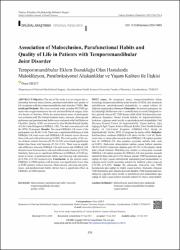| dc.contributor.author | Ekici, Ömer | |
| dc.date.accessioned | 2022-06-22T12:01:36Z | |
| dc.date.available | 2022-06-22T12:01:36Z | |
| dc.date.issued | 2021 | en_US |
| dc.identifier.citation | Ekici, Ö. (2021). Association of Malocclusion, Parafunctional Habits and Quality of Life in Patients with Temporomandibular Joint Disorder. Turkiye Klinikleri Journal of Dental Sciences, 27(4). | en_US |
| dc.identifier.issn | 2146-8966 | |
| dc.identifier.uri | https://doi.org/10.5336/dentalsci.2020-79483 | |
| dc.identifier.uri | https://hdl.handle.net/20.500.12933/1220 | |
| dc.description.abstract | Objective: The aim of this study is to investigate the relationship between malocclusion, parafunctional habits and quality of
life in patients with the temporomandibular joint disorder (TMD). Material and Methods: This cross-sectional study included 482 TMD patients who sought treatment at the oral and maxillofacial surgery clinic
of a faculty of dentistry. While the malocclusion status of participants
was evaluated with The Dental Aesthetic Index, bruxism, chewing side
preference and parafunctional habits were evaluated with Oral Behavior
Checklist. Quality of life was assessed by Oral Health-Related Quality
of Life-United Kingdom (OHRQoL-UK). The data were analyzed with
the SPSS 20 program. Results: The mean OHRQoL-UK score of the
participants was 46.46±11.64. There was a significant difference in both
OHRQoL-UK total scores and OHRQoL-UK domain scores between
those with and without bruxism (p<0.005). The total quality of life scores of those without bruxism (49.29±10.629) were found significantly
higher than those with bruxism (45.54±11.82). There was no significant difference between OHRQoL-UK total scores and OHRQoL-UK
domain scores between those with and without malocclusion (p=0.254).
Similarly, there was no significant difference in OHRQoL of TMD patients in terms of parafunctional habits and chewing side preference
(p=0.300, p=0.548 respectively). Conclusion: In the present study,
OHRQoL in TMD patients with bruxism was significantly lower than
in TMD patients without bruxism. Malocclusion, chewing side preference, and parafunctional habits did not have a significant effect on
OHRQoL in TMD patients. | en_US |
| dc.description.abstract | Amaç: Bu çalışmanın amacı, temporomandibular eklem
bozukluğu [temporomandibular joint disorder (TMD)] olan hastalarda
maloklüzyon, parafonksiyonel alışkanlıklar ve yaşam kalitesi ile
ilişkisini araştırmaktır. Gereç ve Yöntemler: Bu kesitsel çalışmaya, bir
diş hekimliği fakültesinin oral ve maksillofasiyal cerrahi kliniğinde tedavi görmek isteyen 482 TMD hastası dâhil edildi. Katılımcıların maloklüzyon durumları Dental Estetik İndeksi ile değerlendirilirken,
bruksizm, çiğneme tarafı tercihi ve parafonksiyonel alışkanlıklar Oral
Davranış Kontrol Listesi ile değerlendirildi. Yaşam kalitesi, Ağız
Sağlığıyla İlgili Yaşam Kalitesi-Birleşik Krallık [Oral Health-Related
Quality of Life-United Kingdom (OHRQoL-UK)] ölçeği ile
değerlendirildi. Veriler, SPSS 20 programı ile analiz edildi. Bulgular:
Katılımcıların ortalama OHRQoL-UK skoru 46,46±11,64 idi. Bruksizmi olan ve olmayanlar arasında, hem OHRQoL-UK toplam puanları
hem de OHRQoL-UK alan puanları açısından anlamlı fark vardı
(p<0,005). Bruksizmi olmayanların toplam yaşam kalitesi puanları
(49,29±10,629), bruksizmi olanlara göre (45,54±11,82) anlamlı olarak
daha yüksek bulundu. Maloklüzyonu olanlar ve olmayanlar arasında
OHRQoL-UK toplam puanları ile OHRQoL-UK alan puanları arasında
anlamlı bir fark yoktu (p=0,254). Benzer şekilde, TMD hastalarının ağız
sağlığı ile ilgili yaşam kalitelerinde parafonksiyonel alışkanlıklar ve
çiğneme tarafı tercihi açısından anlamlı bir farklılık yoktu (sırasıyla
p=0,300, p=0,548). Sonuç: Bu çalışmada, bruksizmi olan TMD
hastalarında ağız sağlığı ile ilişkili yaşam kalitesi, bruksizmi olmayan
TMD hastalarına göre anlamlı derecede düşüktü. TMD hastalarında maloklüzyon, çiğneme tarafı tercihi ve parafonksiyonel alışkanlıklar ağız
sağlığı ile ilgili yaşam kalitesi üzerinde anlamlı bir etkiye sahip değildi. | en_US |
| dc.language.iso | eng | en_US |
| dc.publisher | Türkiye Klinikleri | en_US |
| dc.relation.isversionof | 10.5336/dentalsci.2020-79483 | en_US |
| dc.rights | info:eu-repo/semantics/openAccess | en_US |
| dc.subject | Malocclusion | en_US |
| dc.subject | Parafunctional habit | en_US |
| dc.subject | Bruxism | en_US |
| dc.subject | Temporomandibular disorder | en_US |
| dc.subject | Quality of life | en_US |
| dc.subject | Maloklüzyon | en_US |
| dc.subject | Parafonksiyonel alışkanlık | en_US |
| dc.subject | Bruksizm | en_US |
| dc.subject | Temporomandibular bozukluk | en_US |
| dc.subject | Yaşam kalitesi | en_US |
| dc.title | Association of Malocclusion, Parafunctional Habits and Quality of Life in Patients with Temporomandibular Joint Disorder | en_US |
| dc.title.alternative | Temporomandibular Eklem Bozukluğu Olan Hastalarda Maloklüzyon, Parafonksiyonel Alışkanlıklar ve Yaşam Kalitesi ile İlişkisi | en_US |
| dc.type | article | en_US |
| dc.authorid | 0000-0002-7902-9601 | en_US |
| dc.department | AFSÜ, Diş Hekimliği Fakültesi, Klinik Bilimler Bölümü | en_US |
| dc.contributor.institutionauthor | Ekici, Ömer | |
| dc.identifier.volume | 27 | en_US |
| dc.identifier.issue | 4 | en_US |
| dc.identifier.startpage | 551 | en_US |
| dc.identifier.endpage | 558 | en_US |
| dc.relation.journal | Türkiye Klinikleri Diş Hekimliği Bilimleri Dergisi | en_US |
| dc.relation.publicationcategory | Makale - Uluslararası Hakemli Dergi - Kurum Öğretim Elemanı | en_US |
















